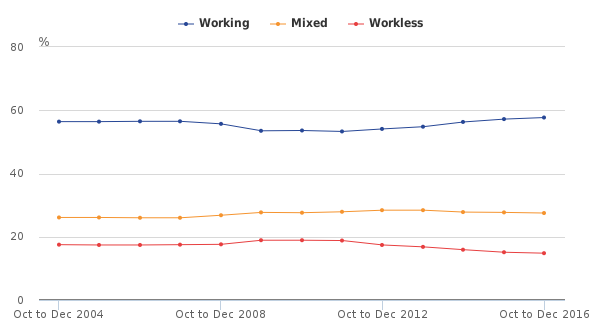
Of the 20.7 million households (where at least 1 member is aged 16 to 64) in the UK, 11.9 million (57.7%) were classed as working, up 107,000 or 0.6 percentage points over the past year.
5.7 million households (27.5%) had a mix of least 1 working and 1 workless adult, down 55,000 or 0.3 percentage points over the year.
There were 3.1 million households (14.8%) classed as workless, down 72,000 or 0.3 percentage points over the last year.
Growth in the share of working households in the UK has been partly driven by increased proportions of lone parents working, which has risen from 55.4% in 2004 to 67.9% in 2016.

Main definitions used by the Office of National Statistics (ONS)
Households
For the purposes of this bulletin, estimates only include those households where at least 1 person is aged 16 to 64.
Student households
Households where all adults are aged 16 to 24 and in full-time education. The definition excludes households where all members are in education but some members are aged 25 years or more.
Working households
Households where all members aged 16 or over are employed.
Workless households
Households where no-one aged 16 or over is in employment. These members may be unemployed or economically inactive. Economically inactive members may be unavailable to work because of family commitments, retirement or study, or unable to work through sickness or disability.
Mixed households
Households that contain both working and workless members.
Other household types
This refers to households that contain 2 or more family units, or 2 or more people belonging to separate family units.
Lone parent households contain at least 1 dependent child under the age of 19. There may be other non-dependent children present, that is those aged over 18.
Employment
A measure of the number of people in work.
Unemployment
A measure of people without a job who have been actively seeking work within the last 4 weeks and are available to start work within the next 2 weeks.
Economically inactive
People who are not in employment but do not meet the internationally accepted definition of unemployment because they have not been seeking work within the last 4 weeks and/or they are unable to start work within the next 2 weeks.
1 comment
Leave a comment
Make sure you enter all the required information, indicated by an asterisk (*). HTML code is not allowed.
Join
FREE
Here










